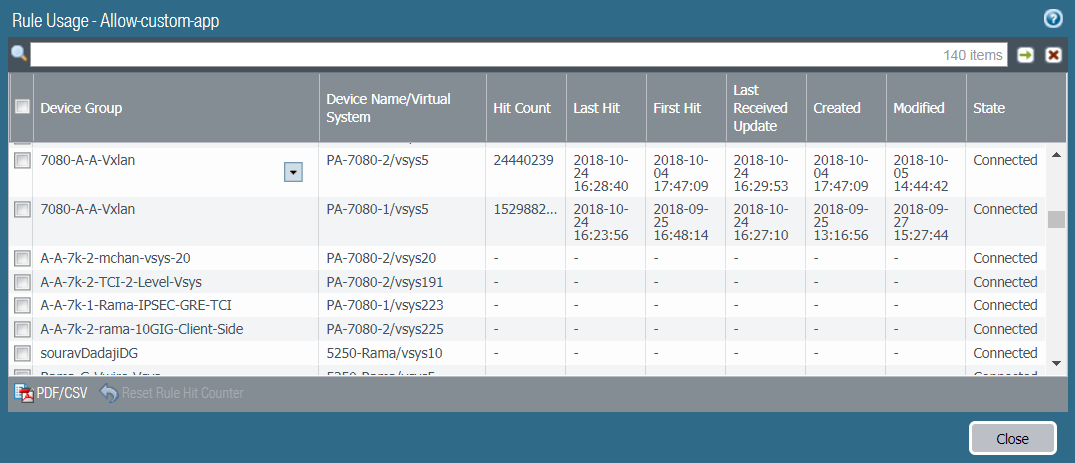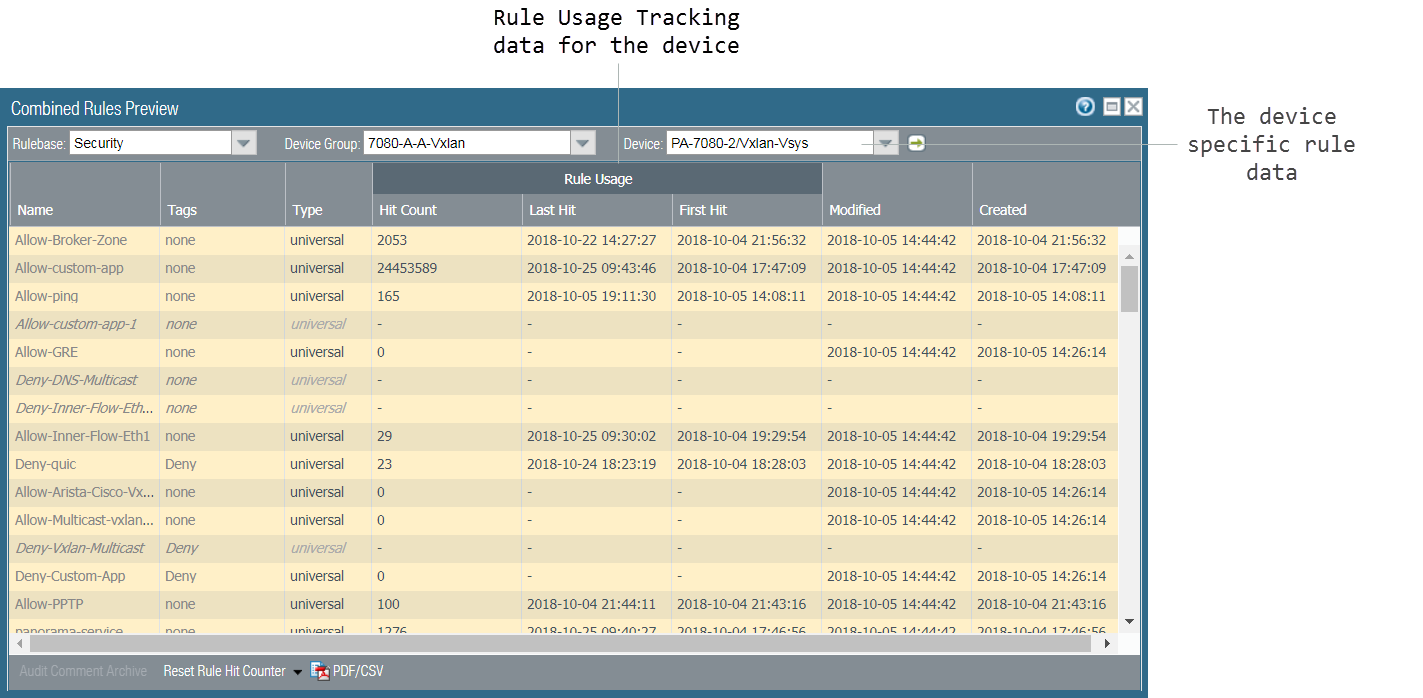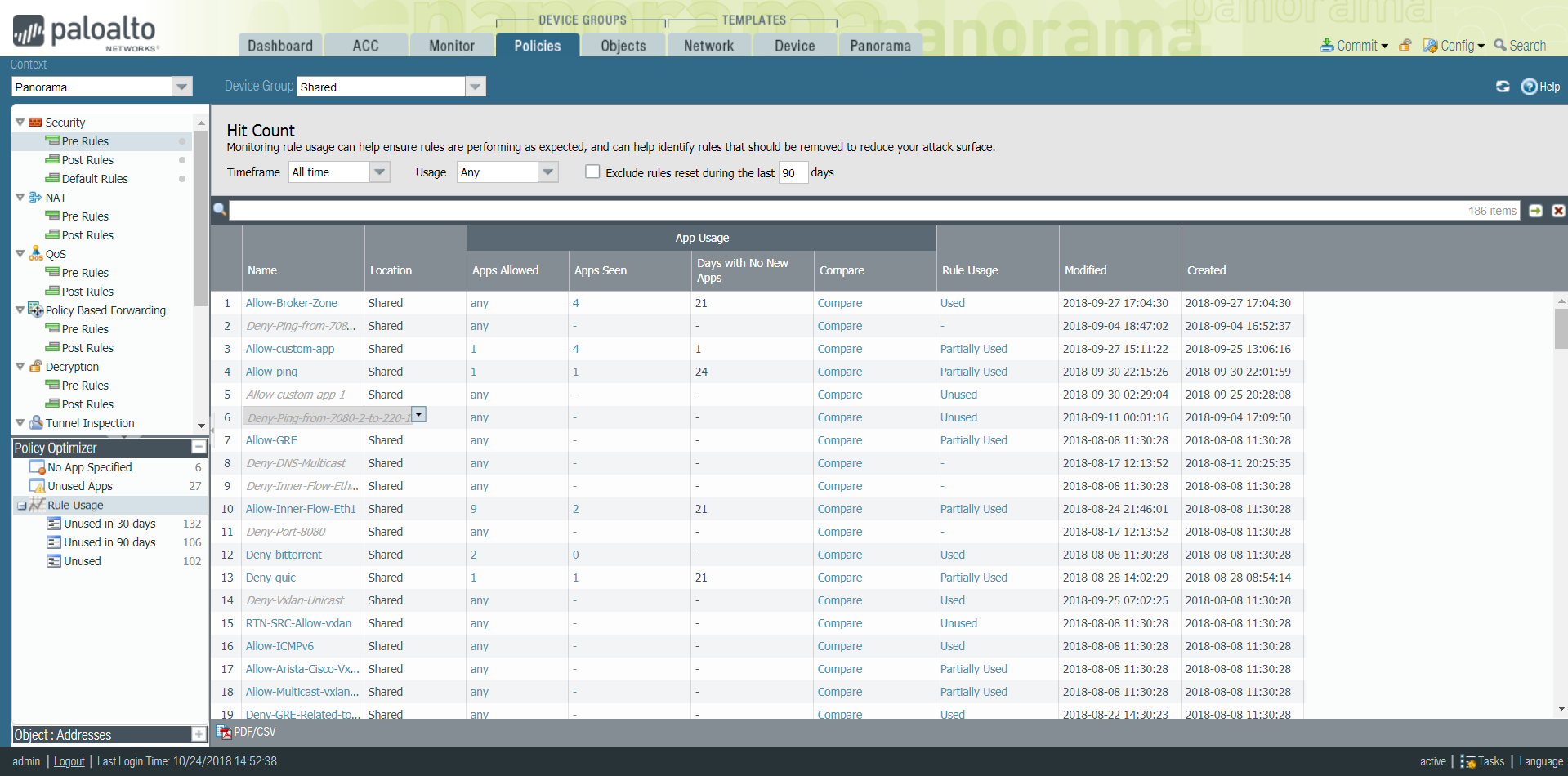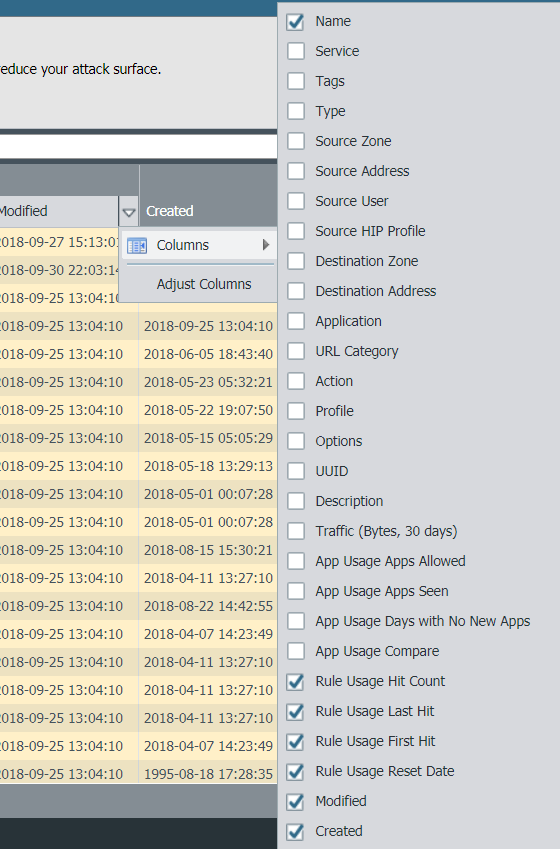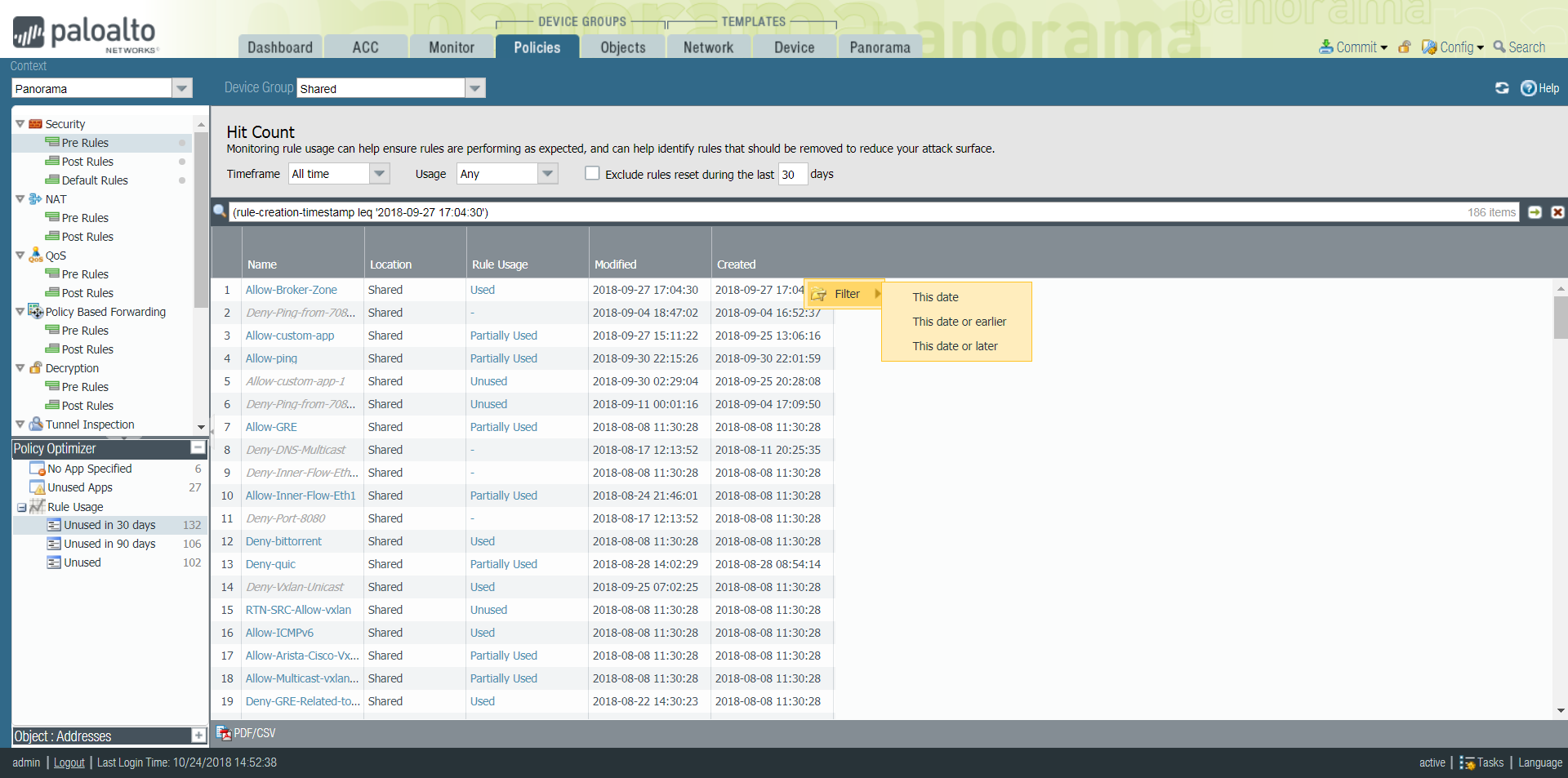Monitor Policy Rule Usage
Table of Contents
9.1 (EoL)
Expand all | Collapse all
-
- Determine Panorama Log Storage Requirements
-
- Setup Prerequisites for the Panorama Virtual Appliance
- Perform Initial Configuration of the Panorama Virtual Appliance
- Set Up The Panorama Virtual Appliance as a Log Collector
- Set Up the Panorama Virtual Appliance with Local Log Collector
- Set up a Panorama Virtual Appliance in Panorama Mode
- Set up a Panorama Virtual Appliance in Management Only Mode
-
- Preserve Existing Logs When Adding Storage on Panorama Virtual Appliance in Legacy Mode
- Add a Virtual Disk to Panorama on an ESXi Server
- Add a Virtual Disk to Panorama on vCloud Air
- Add a Virtual Disk to Panorama on AWS
- Add a Virtual Disk to Panorama on Azure
- Add a Virtual Disk to Panorama on Google Cloud Platform
- Add a Virtual Disk to Panorama on KVM
- Add a Virtual Disk to Panorama on Hyper-V
- Mount the Panorama ESXi Server to an NFS Datastore
-
- Increase CPUs and Memory for Panorama on an ESXi Server
- Increase CPUs and Memory for Panorama on vCloud Air
- Increase CPUs and Memory for Panorama on AWS
- Increase CPUs and Memory for Panorama on Azure
- Increase CPUs and Memory for Panorama on Google Cloud Platform
- Increase CPUs and Memory for Panorama on KVM
- Increase CPUs and Memory for Panorama on Hyper-V
- Complete the Panorama Virtual Appliance Setup
-
- Convert Your Evaluation Panorama to a Production Panorama with Local Log Collector
- Convert Your Evaluation Panorama to a Production Panorama without Local Log Collector
- Convert Your Evaluation Panorama to VM-Flex Licensing with Local Log Collector
- Convert Your Evaluation Panorama to VM-Flex Licensing without Local Log Collector
- Convert Your Production Panorama to an ELA Panorama
-
- Register Panorama
- Activate a Panorama Support License
- Activate/Retrieve a Firewall Management License when the Panorama Virtual Appliance is Internet-connected
- Activate/Retrieve a Firewall Management License when the Panorama Virtual Appliance is not Internet-connected
- Activate/Retrieve a Firewall Management License on the M-Series Appliance
- Install the Panorama Device Certificate
-
- Migrate from a Panorama Virtual Appliance to an M-Series Appliance
- Migrate a Panorama Virtual Appliance to a Different Hypervisor
- Migrate from an M-Series Appliance to a Panorama Virtual Appliance
- Migrate from an M-100 Appliance to an M-500 Appliance
- Migrate from an M-100 or M-500 Appliance to an M-200 or M-600 Appliance
-
- Configure an Admin Role Profile
- Configure an Access Domain
-
- Configure a Panorama Administrator Account
- Configure Local or External Authentication for Panorama Administrators
- Configure a Panorama Administrator with Certificate-Based Authentication for the Web Interface
- Configure an Administrator with SSH Key-Based Authentication for the CLI
- Configure RADIUS Authentication for Panorama Administrators
- Configure TACACS+ Authentication for Panorama Administrators
- Configure SAML Authentication for Panorama Administrators
-
- Add a Firewall as a Managed Device
-
- Add a Device Group
- Create a Device Group Hierarchy
- Create Objects for Use in Shared or Device Group Policy
- Revert to Inherited Object Values
- Manage Unused Shared Objects
- Manage Precedence of Inherited Objects
- Move or Clone a Policy Rule or Object to a Different Device Group
- Push a Policy Rule to a Subset of Firewalls
- Manage the Rule Hierarchy
- Manage the Master Key from Panorama
- Redistribute User-ID Information to Managed Firewalls
-
- Plan the Transition to Panorama Management
- Migrate a Firewall to Panorama Management and Reuse Existing Configuration
- Migrate a Firewall to Panorama Management and Push a New Configuration
- Migrate a Firewall HA Pair to Panorama Management and Reuse Existing Configuration
- Migrate a Firewall HA Pair to Panorama Management and Push a New Configuration
- Load a Partial Firewall Configuration into Panorama
- Localize a Panorama Pushed Configuration on a Managed Firewall
-
- Add Standalone WildFire Appliances to Manage with Panorama
- Configure Basic WildFire Appliance Settings on Panorama
- Remove a WildFire Appliance from Panorama Management
-
-
- Configure a Cluster and Add Nodes on Panorama
- Configure General Cluster Settings on Panorama
- Remove a Cluster from Panorama Management
- Configure Appliance-to-Appliance Encryption Using Predefined Certificates Centrally on Panorama
- Configure Appliance-to-Appliance Encryption Using Custom Certificates Centrally on Panorama
- View WildFire Cluster Status Using Panorama
- Upgrade a Cluster Centrally on Panorama with an Internet Connection
- Upgrade a Cluster Centrally on Panorama without an Internet Connection
-
-
- Manage Licenses on Firewalls Using Panorama
-
- Supported Updates
- Schedule a Content Update Using Panorama
- Upgrade Log Collectors When Panorama Is Internet-Connected
- Upgrade Log Collectors When Panorama Is Not Internet-Connected
- Upgrade Firewalls When Panorama Is Internet-Connected
- Upgrade Firewalls When Panorama Is Not Internet-Connected
- Upgrade a ZTP Firewall
- Revert Content Updates from Panorama
-
- Preview, Validate, or Commit Configuration Changes
- Enable Automated Commit Recovery
- Compare Changes in Panorama Configurations
- Manage Locks for Restricting Configuration Changes
- Add Custom Logos to Panorama
- Use the Panorama Task Manager
- Reboot or Shut Down Panorama
- Configure Panorama Password Profiles and Complexity
-
-
- Verify Panorama Port Usage
- Resolve Zero Log Storage for a Collector Group
- Replace a Failed Disk on an M-Series Appliance
- Replace the Virtual Disk on an ESXi Server
- Replace the Virtual Disk on vCloud Air
- Migrate Logs to a New M-Series Appliance in Log Collector Mode
- Migrate Logs to a New M-Series Appliance in Panorama Mode
- Migrate Logs to a New M-Series Appliance Model in Panorama Mode in High Availability
- Migrate Logs to the Same M-Series Appliance Model in Panorama Mode in High Availability
- Migrate Log Collectors after Failure/RMA of Non-HA Panorama
- Regenerate Metadata for M-Series Appliance RAID Pairs
- Troubleshoot Registration or Serial Number Errors
- Troubleshoot Reporting Errors
- Troubleshoot Device Management License Errors
- Troubleshoot Automatically Reverted Firewall Configurations
- Complete Content Update When Panorama HA Peer is Down
- View Task Success or Failure Status
- Restore an Expired Device Certificate
- Downgrade from Panorama 9.1
End-of-Life (EoL)
Monitor Policy Rule Usage
How to view rule usage for policy rules pushed to a device
group from Panorama.
As your policies change, tracking rule usage
on Panorama helps you evaluate whether your policy implementation
continues to match your enforcement needs. This visibility helps
you identify and remove unused rules to reduce security risks and
keep your policy rule base organized. Additionally, rule usage tracking
allows you to quickly validate new rule additions and rule changes
and to monitor rule usage for operations and troubleshooting tasks.
On Panorama, you can view the rule usage of firewalls in a device
group—to which you pushed policies—to determine if all, some, or
none of the firewalls have traffic matches instead of being able
to monitor only the total number of hits across all firewalls in
a device group. You can quickly filter rules using the rule usage
data, such as Created and Modified dates, within a customizable
time frame. The displayed rule usage information persists across
reboot, dataplane restarts, and upgrades.
On Panorama, you
can view the rule usage details for managed firewalls that are running
a PAN-OS 8.1 or later release, that have policy rule hit count enabled
(default), and for which you have defined and pushed policy rules
using device groups. Panorama cannot retrieve rule usage details for
policy rules configured locally on the firewall so you must log
in to the firewall to view rule usage information for locally configured
rules.
Policy rule usage data may also be useful when
using Policy Optimizer to prioritize
which rules to migrate or clean up first.
Policy rule usage data is not preserved when you transition to a different Panorama model.
This means that all existing policy rule usage data from the old Panorama is no
longer displayed after a successful migration to a new Panorama model. After a
successful migration, Panorama begins tracking policy rule usage data based on
the date the migration was completed. For example, the
Created date displays the date the migration
was completed.
To view the
rule usage across any Shared rule or for a specific device group:
- Log in to the Panorama Web Interface.
- Verify that the Policy Rule Hit Count is
enabled.
- Navigate to Policy Rulebase Settings (PanoramaSetup Management.
- Verify that Policy Rule Hit Count is enabled.
![]()
- Select Policies<policy rule> to view a rule.
- Change the Device Group context to Shared or to the specific device group you want to view.
- Determine whether the rule is being used (Rule Usage).
The policy rule usage status is one of the following:Firewalls must run PAN-OS 8.1 or later release with Policy Rule Hit Count enabled for Panorama to determine rule usage.
- Used—When all firewalls in the device group—to which you pushed the policy rule—have traffic matches for the policy rule.
- Partially Used—When some of the firewalls in the device group—to which you pushed the policy rule—have traffic matches for the policy rule.
- Unused—When no firewalls in the device group—to which you pushed the policy rule—have traffic matches for the policy rule.
- Em-dash (—)—When no firewalls in the device group—to which you pushed the policy rule—have Policy Rule Hit Count enabled or available for Panorama to determine the rule usage.
- Modified—The date and time the policy rule was last modified.
- Created—The date and time the policy rule was created.If the rule was created when Panorama was running PAN-OS 8.1 and the Policy Rule Hit Count setting is enabled, the First Hit date and time is used as the Created date and time on upgrade to PAN-OS 9.1. If the rule was created in PAN-OS 8.1 when the Policy Rule Hit Count setting was disabled or if the rule was created when Panorama was running PAN-OS 8.0 or an earlier release, the Created date for the rule will be the date and time you successfully upgraded Panorama to PAN-OS 9.1
![]()
- Click the Rule Usage status to view the list of firewalls
using the rule and the hit-count data for traffic that matches that
rule on each firewall.
![]()
- (Optional) View the policy rule hit-count data
for individual appliances in the device group.
- Click Preview Rules.
- From the Device context, select the appliance for
which you want to view the policy rule usage data.
![]()
- Select Policies and, in the Policy Optimizer dialog, view the Rule Usage filter.
- Filter rules in the selected rulebase.You can filter the rule usage for rules pushed to firewalls from Panorama. Panorama cannot filter rule usage for rules configured locally on the firewall.Use the rule usage filter to evaluate the rule usage within a specified period of time. For example, filter the selected rulebase for Unused rules within the last 30 days. You can also evaluate rule usage with other rule attributes, such as the Created and Modified dates, which enables you to filter for the correct set of rules to review. You can use this data to help manage your rule lifecycle and to determine if a rule needs to be removed to reduce your network attack surface.
- Select the Timeframe you want to filter on, or specify a Custom time frame.
- Select the rule Usage on which you want to filter.
- (Optional) If you have reset the rule usage
data for any rules, check for Exclude rules reset during
the last <number of days> days and
decide when to exclude a rule based on the number of days you specify
since the rule was reset. Only rules that were reset before your
specified number of days are included in the filtered results.
![]()
- (Optional) Specify search filters based on
additional rule data, other than the rule usage.
- Hover your mouse over the column header, and from the drop-down select Columns.
- Add any additional columns you want to filter with or to display.
![]()
- Hover your mouse over the column data that you would like to filter, and select Filter from the drop-down. For data that contain dates, select whether to filter using This date, This date or earlier, or This date or later.
- Click Apply Filter ().
![]()
![]()



